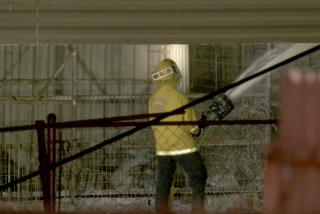Swarm of Virginia Bees Kills Goat, Stings 4 People
- Share via
To Frank, the goat, they were killers for sure.
But Eric Day, a scientist, must approach the issue differently. He is trying to figure out if the swarm that stung Frank to death Wednesday in southwest Virginia consisted of Africanized honeybees, more commonly known as “killer bees.”
James Downey, Frank’s owner and a former beekeeper who was stung more than 35 times by the swarm, thinks it’s a distinction without a difference.
“They killed some goat, a powerful old goat,” Downey said Friday. “I don’t know how much more killer they got to be.”
Day, however, said it is probable the swarm that killed Frank and attacked several people was merely an extremely agitated group of honeybees.
“I wouldn’t expect to find Africanized bees at all,” said Day, manager of the insect identification lab at the Virginia Tech Extension Service. “The way those bees were handled there, it’s not out of their realm. It was a cloudy, rainy day and that makes bees more aggressive.”
But he is checking, because a killer swarm could pose a threat to the community and would be an alarming shift in the migration pattern of the bees.
Africanized bees are slightly smaller than other bees, though they look virtually identical. Under certain conditions they can be extremely belligerent and, in some cases, kill humans and animals when provoked. They are descended from African bees imported to Brazil and accidentally released in 1957. Since then, they have been migrating north and in the last decade have been found in Texas, Arizona, New Mexico, Nevada and California.
Day said it was extremely unlikely they would make the jump to Virginia. His lab won’t know for certain until next week.
Whether Africanized or not, the bees put a scare into Downey, his wife, Nannie, a handful of police, fire and rescue personnel and a construction crew.
Downey tied Frank near a briar patch behind his house in Low Moor, wanting the goat to eat there but not knowing that the patch was home to about 2,000 bees. They attacked the goat.
Alerted by a construction crew working on his house, Downey darted to Frank’s rescue, only to become another target. One of the construction workers tried to help by throwing a cooler of water on Downey before being chased away by the bees. Downey hasn’t seen or heard from him since.
“The last time I seen him, he was running around the side of the house with the bees running after him,” Downey recalled. “That man, you could send him to the Olympics, the way he was moving.”
The former beekeeper then ran into the house, bringing along a few bees that then stung his wife. He grabbed a protective hood, a heavy winter coat and a pair of gloves before racing back outside to help Frank. Meanwhile, his wife called the police.
Within minutes, police, fire and rescue personnel arrived, separating the goat and Downey from the swarm some 20 minutes after the ordeal began.
“It just looked like a cloud coming toward me,” Downey said. “If it hadn’t been for the fire company, I reckon they would have killed me.”
The Downeys and two police officers were taken to the hospital and released. The goat, which was covered with stingers on its ears and mouth, climbed a hill and later died.
More to Read
Sign up for Essential California
The most important California stories and recommendations in your inbox every morning.
You may occasionally receive promotional content from the Los Angeles Times.













